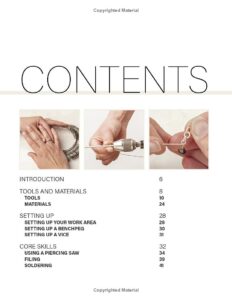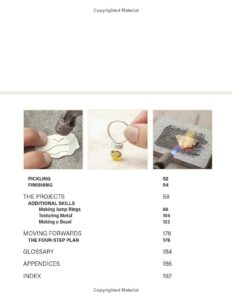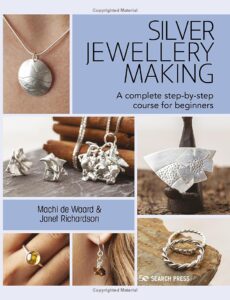Episode 207
What you’ll learn in this episode:
- Why even jewelry novices can learn to make silver jewelry at home with affordable tools
- How Machi and her co-author Janet turned their in-person jewelry making classes into a book
- What safety concerns to consider when making DIY jewelry
- How working with silver compares to working with other metals, and where beginner makers should start
- What mistakes beginner makers commonly make and how to fix them
About Machi de Waard
Machi de Waard is a designer-jeweller and jewellery tutor. Jewellery has been her full-time pursuit since early 2007, and Machi’s work has been shown at galleries, fairs and exhibitions. Machi combines her studio practice with teaching, having taught jewellery making for over ten years in various locations throughout the UK. Her interests in modern art, particularly in sculpture and minimalism, influence her work.
Additional Resources:
www.machidewaard.co.uk
insta: @machi_jewellery
www.janetrichardson.co.uk
insta: @janrichardsonjewellery
Book links:
- Amazon UK
- Waterstones
- Blackwells
- Search Press
- Guardian Bookstore
- Amazon USA
- Penguin Random House
- Bol.com in the Netherlands
- Amazon Germany
Photos (by Mark Davison at Search Press Studios)



Janet Richardson

Transcript:
Working with metal might seem like something best left to the pros, but Machi de Waard’s new book smashes that misconception. Written with Machi’s friend and co-author Janet Richardson, “Silver Jewelry Making: A Complete Step-By-Step Course,” includes seven projects that help beginner makers build on their skills and make real jewelry at home with simple tools. Machi joined the Jewelry Journey Podcast to talk about the serendipitous way the book got published; why silver is the best metal for beginners to start with; and which common mistakes DIY makers should watch out for. Read the episode transcript here.
Sharon: Hello, everyone, welcome to the Jewelry Journey Podcast. This is the second part of a two-part episode. If you haven’t heard part one, please head to TheJewelryJourney.com.
Today, my guest is Machi de Waard. She, along with Janet Richardson, is the coauthor of the book “Silver Jewelry Making.” They are both jewelers and teachers in Great Britain, and that’s where she’s speaking to me from. Welcome back.
That’s what I wanted to ask you. Do people say to you, “Why do you work in silver and not gold?”
Machi: I’m happy to do any commission in gold. We both do commissions in gold. It’s just harder to afford to do large pieces in gold unless somebody’s already paying you to do it. It’s just very, very expensive.
Sharon: Do you ever rhodium plate your silver with Argentium, or whatever that brand name is?
Machi: Argentium. I use a lot of Argentium in my own work, almost exclusively but not quite, because it doesn’t tarnish as much as sterling silver. Janet uses some Argentium silver and sterling silver. I do not rhodium plate partly because rhodium has actually become very expensive as well, and I prefer not to plate things because if there’s a plate, it can come off. You don’t want the customer to have a piece that looks great and then you have to replate it over a few years. So, I don’t really like to plate my pieces unless absolutely necessary. I don’t think Janet does much plating either.
Sharon: What’s your favorite kind of thing to make? Is it a bracelet, a ring, a necklace?
Machi: Oh, I like all of it. I think Janet and I are both—what’s the word—I was going to say obsessed, but maybe passionate sounds better. We are both never bored of jewelry. We like to make pretty much everything. I would say at the moment, my favorite thing is brooches, but I’m happy to make anything.
Sharon: I’m not any kind of maker, but it seems like a brooch would be easier because you only have to make one of those, as opposed to an earring or something where they have to match.
Machi: Yeah, I suppose so, although earrings don’t have to match.
Sharon: Today they don’t. That’s true.
Machi: In the 20s they wore mismatched earrings, so you can always use that excuse. I guess with the brooch, the important thing is the pin. You want a really good pin that’s going to hold the brooch up and it’s not going to flop forward. It will hold on to whatever you’re wearing but also not be impossible to put on and off. There are different things for each piece that you have to look out for.
Sharon: What do you teach your students about pins? Before you even start, do you have to think about what kind of fabric it’s going to be worn with?
Machi: Yes, absolutely. A really small brooch, you could wear on linen, but you have to think about the size of the pin, the material you’re going to put it through, how it’s going to hang, how heavy it is, whether you want a double pin. There are all kinds of different things you can put it on. It depends what you want to use it for, because it’s totally different if you want it for, let’s say, a winter wool coat versus holding on a silk scarf. It really depends on the end use. You have to think about that before you start making.
Sharon: What are the other things you counsel your students to think about before they start?
Machi: The order of fabrication. If you don’t think about it and then you get halfway through your project, then you realize, “Oh, I should have done that before that,” that can cause problems. It’s important to have at least a basic plan of the order you’re going to do things in so that it works out.
Sharon: Does your book talk about that? It talks about fabrication?
Machi: Yes.
Sharon: Did you have to look for a while before you found a publisher? I can’t remember.
Machi: It was actually quite funny. I had been talking to not only Janet, but my other jewelry friends, and I said, “Oh, Janet and I are going to write a book,” and of course it didn’t happen. Then one of our jewelry friends was at a craft fair and a publisher, which turned out to be Search Press, approached her and said, “Do you want to write a book about jewelry making?” and she said, “No, absolutely not, but I know somebody who does.” Then Janet and I approached Search Press and proposed what we wanted to write, and it was exactly what they were looking for. It was total serendipity. We wanted to write exactly what they wanted somebody to write for them.
For us, it was fantastic because Search Press is an award-winning craft publisher. Not only are they excellent at editing and putting together the actual book and the layout and so on, but we had a professional photographer for, I think, five days and we worked in the photography studio. We made the things in the studio and the photographer could take pictures of every little detail. We were worried that maybe there would be a limit on the number of pictures they would take, but he took thousands of pictures. We got all the detailed photographs we wanted, which was so important for visual learners especially, to be able to see exactly what we were talking about.
Sharon: Do you have to be a visual learner for this to work?
Machi: I don’t think so, but that’s because I’m a reader and Janet’s a visual learner. She’ll look at all the pictures and I’ll look at all the words. It turned out to be perfect for the balance, because I was constantly checking the words and she was constantly checking the pictures.
Sharon: I guess I’m not a do-it-yourselfer. Can I learn how to make the jewelry that you talk about in this book?
Machi: Yeah, totally. If you want to, absolutely.
Sharon: If I want to, that’s the question. Did the two of you ever teach together in a classroom or any kind of school?
Machi: No, we generally teach our own classes, but we’ve covered each other’s classes quite a bit. When her husband was unwell, I covered her classes, and when I was doing this degree, she covered my classes. We’re very comfortable taking over from each other because we know what the other is doing.
Sharon: Did you think about doing this book with somebody else?
Machi: No, it had to be Janet.
Sharon: What would she tell me about working with you?
Machi: I think she would say that we complement each other very well. Janet can do everything she wants to with computers, but it’s definitely not her favorite thing. So, I did all the typing. We did everything together. Part of it was during lockdown, so we did loads over Facetime. We would talk over Facetime while I was typing. I typed everything, so that worked out really well. She definitely would have gotten mad at the computer at some point and probably thrown it out the window.
Sharon: Was one of you responsible for CAD or anything like that? When you talk about computers, I think of things that are much more intricate than typing.
Machi: This was just typing. It was just about formatting the text so the publisher could take it and rework it into the format they wanted for the book.
Sharon: Did the publisher tell you how long they wanted it to be or what they wanted in the book?
Machi: Yeah, that was way back at the beginning. When we sat down with them, they said, “O.K., it’s going to be 192 pages.” “O.K.” From the get-go, they knew exactly what they wanted, and then we worked with them within those parameters. It’s also quite funny; jewelers notoriously have terrible nails because they’re constantly getting their nails dirty and breaking. It was actually in the contract that we had to get a manicure before we got the pictures done for the book so our nails wouldn’t be too disgusting.
Sharon: Wow! That’s like a manicurist. A manicurist usually has nails that aren’t done.
Machi: Actually, yeah.
Sharon: So, you had to get manicures before the photos were done.
Machi: Yeah.
Sharon: What kind of troubleshooting tips do you give in the book?
Machi: This is where our experience with teaching really shows because we know in a classroom setting when students get stuck and when they get frustrated. The troubleshooting is about the points that are more difficult. For example, with soldering, there are a lot of little details that can go wrong, and people get frustrated. There’s a whole section about solder troubleshooting.
Then there’s also quite a bit about making joins. Whenever you put something together, like a ring or a bangle or a jump ring, the join has to be really good. It has to be clean, and it has to fit fairly well. So, there’s a whole section about what to do if your join is not good and how to fix it.
There’s also troubleshooting for stone setting because there’s a bit of a temptation, especially with your first-ever stone setting, to get excited and put the stone in to test if it fits before you should put it in, before the item, whatever it is, is finished. Then people get their stones stuck. There’s a whole section for four different ways to get your stone out of a setting because you’ve put it in too early.
Sharon: Can you do something if a join doesn’t fit? If a jump ring doesn’t fit, what can you do?
Machi: Yeah. A clear example is when you make a ring and it’s too small or too big. What do you do? If it’s too small, you can put it back on the ring mandrel, which is like a steel-tapered tool you form the rings around. You can put the ring on it, and then you use a mallet, which is a soft hammer, and you hit it down the mandrel so it stretches it. Just because your ring is too small, all is not lost. You can still stretch it. If it’s too big, you can cut out a little piece and then resolder it and make it the right size. There’s usually some way of fixing it.
Sharon: Do you talk about that just in your classes, or do you also talk about that in the book?
Machi: It’s in the book.
Sharon: Wow! Is the book available everywhere that you would buy an art book?
Machi: I checked and it’s available on Amazon U.S., of course, and Target. I’m trying to remember the other American things. I looked up on the internet where it is. To my surprise, it was available in the Brooklyn Library, which is nice.
Sharon: I’m surprised it’s available in the U.S. I hadn’t thought to look, but I guess it makes sense with Amazon U.S. being so big. I’ve encountered books that are just in Great Britain and they’re not in the U.S., so that’s what I was thinking.
Machi: I think that’s part of the advantage of working with Search Press because they have so much experience in this arena. They got the book absolutely everywhere. It’s on Amazon U.S., U.K., Holland, Japan, Scandinavia, everywhere. It’s also on Penguin U.S., I think on the website. I’m not totally sure if it’s on the website, but it’s definitely available everywhere, basically.
Sharon: Did they do the translating?
Machi: Yup.
Sharon: So, you didn’t have to be involved or worry about any of that.
Machi: No, I don’t even know the details of that. They just took over all of that because they’re super-experienced with these things.
Sharon: That’s pretty good. What’s your next book?
Machi: We vaguely have an idea to do a follow-up book for this, but I think I might have to convince Janet of it. We’ll see.
Sharon: Focusing on silver jewelry again?
Machi: Yes, definitely. We both love making and we love teaching. We just enjoy watching our students go from strength to strength and make their own pieces. Giving people the ability to work on their own is definitely very satisfying.
Sharon: You talk about picking a project in the book and taking it further. Can you give me some examples of that?
Machi: We do the preliminary part of that, and at the end of every project in the book, there’s a progression section which says, “Well, now that you can do this, you can do that.” For example, once you have done all the projects, all the way at the end, it shows that you can also make cufflinks and tie tacks based on the information you’ve learned throughout the other projects. We tried to cover as many different types of pieces of jewelry as possible, so that at the end you can do that.
After that, there’s a section in the back about how to design your own jewelry and how to move forward with thinking about how to design and progressing to make other things. It’s all building blocks. You need the core skills, which are described in great detail, and you can constantly refer back to those, but you can keep building and building and then using the troubleshooting sections to get you out of problems.
Sharon: It would seem like after you write one book, you’d say, “That’s it. I’m done.” What makes you want to write another book?
Machi: I’m not so sure we will because this one took three years from beginning to end. It was a lot of work. It was really, really satisfying, especially because Search Press gave us such a good photographer. It really made it to a quality level that we were very happy with. It had so much detail in the photography and the words. We were really pleased with the outcome and with the feedback we’ve had. We’ve had really good feedback from people saying, “I always use this book to get me out of problems when I’m working on my own.” That’s really satisfying. Whether we’ll actually do another one, I don’t know. I have to talk to Janet again.
Sharon: What would be on your wish list? I keep going back to this. Would it be gold? Would it be silver? Would it be copper?
Machi: I think silver again because this is just seven projects, but there’s no end to how many projects you could do. For example, I’d be interested in adding a project about doing a box, working with hinges, doing gold foil—which is called keum-boo, where you fuse gold foil to silver—or making a large bangle. There’s no end to the possibilities, but just moving it up with different levels of complexity.
Sharon: Fusing gold to a silver object, that seems like it would be asking for trouble in the sense that you’re asking for something to come off.
Machi: Well, the gold foil fusing is actually bonding, so it becomes one metal. It can’t come off. You could scratch it, but you can’t take it off if you do it correctly.
Sharon: Do you see this being the start of your empire, you and Janet, the start of an empire of silver and then going on to bronze or gold or some other metal?
Machi: Both of us just really love silver and the accessibility of silver. Some other people have written very good books about gold. Gold is a whole other thing. I think with silver, there’s so much more to explore that still stays accessible in terms of cost. I think we would probably be more interested in that. I am not sure. It depends. I have to bribe Janet.
Sharon: I’ve heard people say they don’t like silver because you have to polish it and polish it—I’m talking about sterling silver—if it’s not plated. Somehow that stops it from tarnishing.
Machi: There is no getting around that. Sterling silver will tarnish, but it does tarnish more if you don’t wear it. Like a ring, if you just wear it all the time, it generally is going to tarnish less, although it does depend on your skin. Some people’s skin reacts with silver more than others. That’s why I use a lot of Argentium silver, because it tarnishes far less than regular sterling silver. It’s technically more tarnish resistant. It doesn’t not tarnish, but it’s definitely less, so there’s less maintenance with it. That’s why I use that. Janet also uses it to some degree.
Sharon: Is it more expensive?
Machi: A fraction, but nothing significant. Sterling silver is 92.5% silver with the rest being copper, and Argentium silver is 94% silver. It has a higher silver content. It also is copper, but it has a little bit of germanium. The germanium forms an oxide on the outside of the metal, which stops it from tarnishing so it stays white. Well, it doesn’t entirely stop it from tarnishing, but it keeps it from tarnishing as much as sterling. It definitely stays cleaner. If you’re very bothered by tarnish or if you find that you’re cleaning your jewelry, I would say to look for Argentium silver jewelry.
Sharon: Is that something you talk about in the book or in your classes?
Machi: I do talk about that in my classes. It’s not in the book, but that’s partly because when you start, it’s just easier to access sterling silver. Now, you can get Argentium in the U.S. and here, no problem, but Argentium was changing slightly. The inventor of Argentium changed the alloy slightly last year, so it’s better than it was before, but it was still shifting; things were changing. We didn’t discuss it in the book because it would have been too much other information. There’s only so much you can cover with jewelry that we had to limit it somehow.
Sharon: 192 pages is still quite limiting.
Machi: Yeah, and there’s still a lot in there.
Sharon: What is the difference rhodium and Argentium?
Machi: Rhodium is really used only for plating. Argentium is another silver alloy. So, there’s sterling silver and Argentium silver.
Sharon: So, you would make something first and then dip it. I don’t know. I have this image of dipping it in the rhodium, but you would make it out of Argentium first.
Machi: Yes, rhodium is a very traditional thing to plate with. White gold especially is often plated with rhodium to keep it very white and then it doesn’t tarnish. Silver is generally not rhodium-plated, or at least not for individual makers because it wouldn’t make sense cost-wise. It would add a significant amount of cost. Most silver you buy from an individual maker is not going to be plated.
Sharon: That’s interesting. I’ve been told that white gold in its natural form yellows over the years. I don’t know if that’s true or not.
Machi: Yeah, that’s why white gold usually is plated with rhodium gold, especially if it’s commercially imported, to guarantee it’s rhodium plated. At the moment, there’s a bit of a shift going on in the industry with rhodium, partly because it was getting so expensive and partially for environmental reasons. It’s not that environmentally friendly. A whole bunch of the platers I use in London were moving away from rhodium to different white metals to change the way they plate so there were fewer environmental issues. So, there’s a bit of a shift going with that. You’ve got to watch the space. Things are changing on that.
Sharon: So, you go back to the same people to buy your stuff from. You keep going back to the same to people buy it. That’s interesting.
Machi: Yes, and we have a list in the book—no, we don’t have a list. We mention a couple of suppliers, but there’s actually a list on the publisher’s website for suppliers because suppliers change, of course. In the U.S., the main supplier is Rio Grande, and in the U.K., the main supplier is Cooksongold. Those are the big suppliers. Their websites are excellent, which makes it much easier to order the materials.
Sharon: Are they related, Cooksongold and Rio Grande? I know Rio Grande. Are they related?
Machi: No, not as far as I know. Their owners aren’t the same, so I don’t think so.
Sharon: O.K. Machi, thank you very much. I’m glad to know that it’s not Machi, it’s Machi. Thank you. I looked at that and thought, “It sounds right.” It’s M-A-C-H-I, and the last name has a “D-E” and then a capital “W-A-A-R-D.” The book is available now. It’s “Silver Jewelry Making,” and it’s available from Search Press.
Machi: Yes.
Sharon: You can find it in the U.K. and in the U.S. and all over the world, it sounds like, or they can contact you. Thank you, and thank you to Janet. We’ll look forward to your next book.
Machi: Thank you very much.
Sharon: Thank you for being here today.
We will have photos posted on the website. Please head to TheJewelryJourney.com to check them out.

